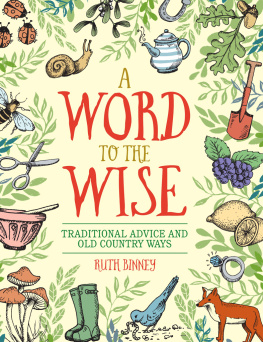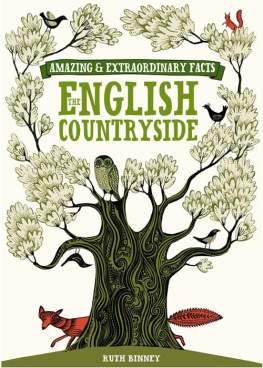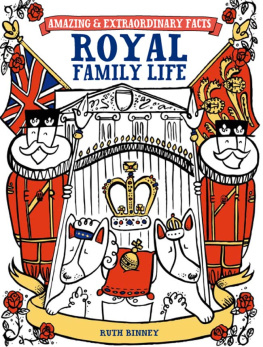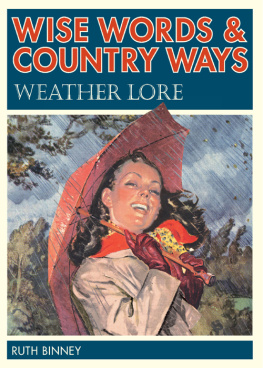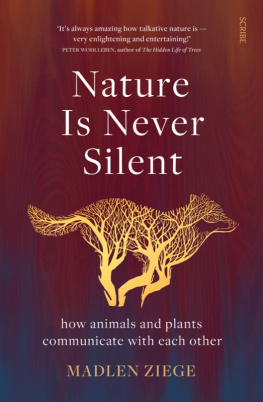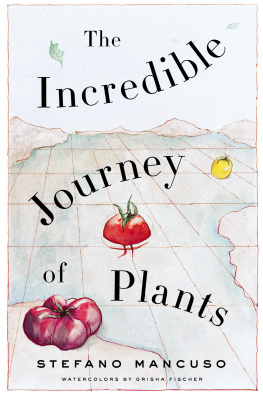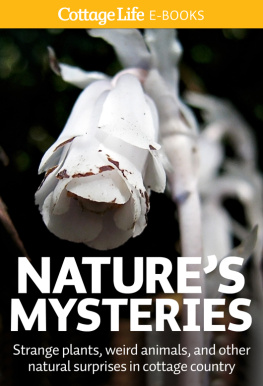NATURE'S WAYS
To my mother, who introduced me to the natural world.
NATURE'S WAYS
lore, legend, fact and fiction
RUTH BINNEY

David and Charles
A DAVID & CHARLES BOOK
Copyright David & Charles Limited 2006
David & Charles is an F+W Publications Inc. company
4700 East Galbraith Road
Cincinnati, OH 45236
First published in the UK in 2006
Text copyright Ruth Binney 2006
Ruth Binney has asserted her right to be identified as
author of this work in accordance with the Copyright,
Designs and Patents Act, 1988.
All rights reserved. No part of this publication may be
reproduced, stored in a retrieval system, or transmitted,
in any form or by any means, electronic or mechanical,
by photocopying, recording or otherwise, without prior
permission in writing from the publisher.
A catalogue record for this book is available from
the British Library.
ISBN-13: 978-0-7153-2417-2 hardback
ISBN-10: 0-7153-2417-9 hardback
Printed in Great Britain by CPI Bath Press
for David & Charles
Brunel House Newton Abbot Devon
Commissioning Editor Neil Baber
Assistant Editor Louise Clark
Project Editor Beverley Jollands
Designer Emma Sandquest
Production Controller Kelly Smith
Visit our website at www.davidandcharles.co.uk
David & Charles books are available from all good
bookshops; alternatively you can contact our Orderline
on 0870 9908222 or write to us at FREEPOST EX2
110, D&C Direct, Newton Abbot, TQ12 4ZZ (no stamp
required UK only); US customers call 800-289-0963
and Canadian customers call 800-840-5220.
CONTENTS
INTRODUCTION
For as long as I can remember, I have been intrigued by 'nature's ways'. From early in childhood I would walk with my mother along the Grand Western Canal near Tiverton, in Devon, collecting leaves, picking wildflowers (in those days an altogether acceptable activity) and then taking them home to be pressed, identified and named.
There were magical moments seeing a dragonfly emerge or an adder basking in early spring sunshine and there was frogspawn to collect in a jar in the hope of nurturing at least a few adult amphibians. Away from the water, up the lane, was the 'wishing tree', and I never missed the ritual of running round it three times and making a secret wish. On holiday in Scotland, I swam in the deep, dark waters of Loch Ness, trying to imagine whether I really was sharing space with the famous monster.
In adulthood I am now more fascinated than ever by plants and animals, not just for themselves, but by the ways that we relate to them and the ways in which they affect our lives. I know for certain that I am not the only person who watches the oaks and ashes in spring to see which is first in leaf (and so predict whether the summer will be wet or dry) and feels a surge of joy at the sight of the first swallow or a kingfisher at any time of year. What strikes me most strongly is that even those of us lucky enough to live in the country are not, as a rule, as close to the plants and animals who share our planet as our forebears were, and that so many of the legends and folktales, myths and superstitions about living things reflect both this past closeness and a desire to explain nature's wonders and mysteries.
When I started to think about this book, and to organize the huge amount of research I had collected, I was overwhelmed by how much there was. However, the main themes that emerged key strongly into the ways in which we relate to plants and animals and tell tales about their origins and behaviour. It quickly becomes clear how we use them as symbols and tokens, how we explain their actions, how they may help, heal and feed us, how they have become the focus of superstitions and sayings and why we should treat them with respect or even fear them. As well as the realities of nature, I also delved into the fascinating world of 'invented' creatures, which reveal yet more secrets of our longstanding relationship with animals and plants.
Once again, I am indebted to my friends and family for their support, especially my husband Donald for his patience while I trawl the shelves of second-hand bookshops and market stalls for tempting volumes, and to my daughter Laura for her constant encouragement. My good neighbours Gordon and Maureen Shaw have provided many valuable snippets from their 'attic collection', notably a source of Romany recipes (which must not, like the others in this book, be tried at home under any circumstances). The London Library, as ever, has proved a treasure trove of books. My thanks go also to my editor Neil Baber and the team at David & Charles, and to Beverley Jollands for her meticulous editing.
More than ever, the plant and animal inhabitants of the natural world deserve our care and respect. By understanding more about the many ways in which they touch our lives even if these are fanciful I hope, like me, you will find your love of nature hugely enhanced.
Ruth Binney
ANIMAL WAYS
The characters of animals have become an integral part of our descriptive language. Owls are wise and lions are brave; bears are strong and monkeys mischievous. As they were establishing the first civilizations, humans must have quickly come to recognize which of the creatures who shared their world were harmful and dangerous and which were useful whether to guard their homes, as means of transport, or as sources of food.
So strongly embedded are the supposed characters of many animals that the ancients believed these creatures to be the embodiments of deities or to be closely linked with them. In countless tales told down the ages and, of course, in the Bible the powers of animals are colourfully recounted, often with some kind of moral attached. As a result it has become only natural to think of snakes as evil (though they can also be good), of rats as dirty and of donkeys as stupid. From their typical behaviour, and their place in lore and legend, certain animals have also become symbolic of all kinds of attributes. So the dove is a bird of peace, the eagle an emblem of victory and the swan the symbol of pure beauty.
In folklore, animals can do almost anything. They can be friends and foes to the people with whom they share the planet, and can talk to each other with ease. They can be evil witches and devils in disguise and the objects of hate and opprobrium. They can bring good luck and bad. In real life they can, as our domestic pets, be our dearest companions, to the point of sheer worship, even helping to heal our ills.
LITTLE BIRDS THAT KNOW
Since ancient times birds, because of their keen eyesight and aerial view of the world, have been linked with wisdom and knowledge. Owls and ibises are believed to be especially wise.
A wise old owl sat in an oak,
The more he saw the less he spoke,
The less he spoke the more he heard,
Wasn't that owl a wise old bird?
In the days of King Arthur and his Knights of the Round Table, the owl was linked with the wizard Merlin, and was customarily depicted on his shoulder. The 'real' Merlin was probably a Celtic bard.
Thus runs the children's rhyme (which is as much a lesson in listening as on the good sense of the owl, and has the alternative last line 'Why can't we all be like that wise old bird?'). However the owl's association with knowledge stems largely from the fact that the bird was companion to Athene, Greek goddess of wisdom, sciences and arts. So strong was the connection that Athenian coins bearing the head of the goddess on one side were marked on the other with an owl and an olive branch (symbol of peace and plenty) from the tree believed to have been given to the earth by Athene. However, there is no known link between the owl's symbolic wisdom and its naturally 'bespectacled' knowing looks.


